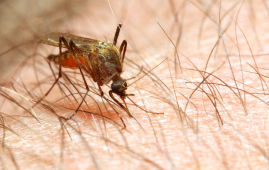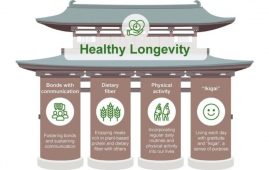

In a world of selfies and profile pictures, you may spend a lot of time staring at your face. And it can be hard not to scrutinize every angle — including your jawline. Maybe you’re wondering if there’s a way to get rid of that double chin.
“Typically, a double chin corresponds with carrying excess weight. But there’s no scientific evidence supporting a clear-cut way of losing it besides diet and exercise,” notes health and fitness specialist Chris Dempers. “Evidence for other methods is only anecdotal.”
We talked to Dempers about his best tips to target chin fat.
What causes a double chin?
Dempers says obesity is the main cause of a double chin. “As people gain weight, many gain it evenly all across their body, including in the face and chin area,” he says.
There are genetic factors, too. “Some people inherit a stronger jawline while others have a softer one, even if they are thin,” he adds. “Being naturally thin doesn’t mean your body fat composition isn’t high. You can still look thin and have less muscle density.”
The best way to get rid of a double chin
Dempers says to watch out for supposed quick fixes when it comes to losing a double chin. Instead, a healthy diet and regular exercise are most likely to get you the desired results.
But if you still want to try to target excess chin fat, Dempers gives the skinny on two methods that some swear by:
1. Jaw exercise tools
Jaw exercise tools are small devices that you put in your mouth and bite down on to exercise your face and neck muscles. “With proper use, they may help improve the jawline by increasing the jaw muscles,” explains Dempers.
But like any exercise program, if you’re not safely and correctly training your neck and jaw muscles, you run the risk of injury. You can overwork and strain the dozens of muscles there.
“Using jaw exercise tools incorrectly and excessively increases your risk of developing temporomandibular joint disorder (TMJ),” says Dempers. “They’re like the sugar pill in medical studies. You may think it’s the device getting you results, but most people using them also work out in the gym. Anyone following a healthy diet and exercising an hour a day is going to lose weight and see it in their face.”
2. Double chin exercises
Certain “double chin” exercises target neck muscles, but that doesn’t mean they will rid you of chin fat. “Stronger neck muscles don’t automatically mean less fat. For example, you can do a thousand crunches a day, but if you still exceed your ideal calorie intake, belly fat is not going to go away.” So double chin exercises can support, but not replace, regular diet and exercise.
How to lose weight (and that double chin)?
Since weight loss is the key to a more defined jawline, Dempers offers four tips to jump-start yours:
1. Start slow
Don’t feel like you have to get up and run a marathon tomorrow, says Dempers. “Just walking 10 or 15 minutes a day can start you on the road to fitness.”
2. Make use of fitness apps and reputable websites
If knowing what to eat seems overwhelming, some good fitness tracking apps do the work for you, says Dempers. These apps can help you:
- Track the calories you eat and burn.
- Scan grocery store items to get nutrition information.
- Understand how much protein, fiber and fats you should have.
“Everyone needs a different number of calories. These apps allow you to enter your biometric information so they can calculate your metabolic rate or calorie allotment.”
Dempers also notes that there’s a lot of great information and guidance online you can access on government websites, such as MyPlate.gov.
3. Connect with a fitness professional
Fitness professionals have education and training that can help you achieve your goals faster. If you can afford it, partner with a dietitian or trainer for optimal results. But simply having an exercise buddy can help you reach your goals as well. “Having a trainer or workout partner can help keep you accountable, on track and motivated,” says Dempers.
4. Don’t be too calorie-restrictive
While ideal calorie counts vary, Dempers cautions us never to eat less than 1,200 calories a day. “That’s low even for someone who is smaller and needs fewer calories. That 1,200-calorie threshold may be higher depending on your size and activity level,” he says. “You need proper fuel, nutrients and fats to help brain function and for your overall health.”
Weight loss is a long game, reminds Dempers. And patience will be your secret ingredient to success. “Nowadays, everyone wants a quick fix, but with weight loss, you’ll do better with a slower process. Aim to lose around one to two pounds a week. Cutting out 500 calories a day adds up quickly to see results on your waistline — and your jawline.”
more recommended stories
 Ultramarathon Physiology: What HCPs Should Know?
Ultramarathon Physiology: What HCPs Should Know?Ultramarathon Metabolism: What Happens to the.
 High-Intensity Training and Oxidative Stress Insights
High-Intensity Training and Oxidative Stress InsightsNew Evidence Linking High-Intensity Training and.
 Sterilized Fermented Beverage for Obesity: New Evidence
Sterilized Fermented Beverage for Obesity: New EvidenceEarly Insights Into a Sterilized Fermented.
 Cardiovascular Risk and Sudden Cardiac Death in Diabetes
Cardiovascular Risk and Sudden Cardiac Death in DiabetesRising Sudden Cardiac Death (SCD) Risk.
 Perinatal Mental Health Challenges Highlighted in New Study
Perinatal Mental Health Challenges Highlighted in New StudyMental Health Challenges in New Parents:.
 Walking Speed Before Hip Replacement Predicts Recovery
Walking Speed Before Hip Replacement Predicts RecoveryNew Evidence Points to a Simple,.
 How Soybean Oil Impacts Weight Gain and Metabolism
How Soybean Oil Impacts Weight Gain and MetabolismWhy Soybean Oil May Affect Metabolism.
 New Malaria Prevention Insights From African Biostatistics
New Malaria Prevention Insights From African BiostatisticsHow New Data Is Reframing Malaria.
 World Summit Outlines Core Principles for Healthy Longevity
World Summit Outlines Core Principles for Healthy LongevityWhy Healthy Longevity Demands a New.
 Gut Immune Cells and Long-Lasting Antiviral Protection.
Gut Immune Cells and Long-Lasting Antiviral Protection.Breakthrough Findings on How Gut Immune.

Leave a Comment